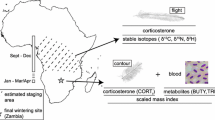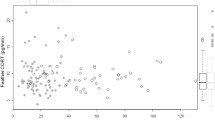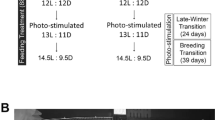Abstract
Migratory birds make decisions about how far to travel based on cost-benefit trade-offs. However, in many cases the net effect of these trade-offs is unclear. We sought to address this question by measuring feather corticosterone (CORTf), leucocyte profile, avian malaria parasite prevalence and estimating fueling rates in three spatially segregated wintering populations of the migratory shorebird ruddy turnstone Arenaria interpres during their stay in the winter habitat. These birds fly from the high-Arctic breeding ground to Australia, but differ in that some decide to end their migration early (Broome, Western Australia), whereas others travel further to either South Australia or Tasmania. We hypothesized that the extra costs in birds migrating greater distances and overwintering in colder climates would be offset by benefits when reaching their destination. This would be evidenced by lower stress biomarkers in populations that travel further, owing to the expected benefits of greater resources and improved vitality. We show that avian malaria prevalence and physiological stress levels were lower in birds flying to South Australia and Tasmania than those overwintering in Broome. Furthermore, our modeling predicts that birds in the southernmost locations enjoy higher fueling rates. Our data are consistent with the interpretation that birds occupying more costly wintering locations in terms of higher migratory flight and thermoregulatory costs are compensated by better feeding conditions and lower blood parasite infections, which facilitates timely and speedy migration back to the breeding ground. These data contribute to our understanding of cost-benefit trade-offs in the decision making underlying migratory behaviour.



Similar content being viewed by others
References
Aharon-Rotman Y, Gosbell K, Minton C, Klaassen M (2015a) Why fly the extra mile? Latitudinal trend in migratory fuel deposition rate as driver of trans-equatorial long distance migration. In: Aharon-Rotman Y. Challenges within the annual cycle of long-distance migratory waders along the East Asian-Australasian Flyway, PhD dissertation, School of Life and Environmental Science, Deakin University, Geelong, Australia
Aharon-Rotman Y, Klaassen M, Buchanan KL, Buttemer WA (2015b) An experimental examination of interindividual variation in feather corticosterone content in the House Sparrow Passer domesticus in southeast Australia. Gen Comp Endocrinol. doi:10.1016/j.ygcen.2015.12.010
Al-Murrani WK, Al-Rawi AJ, Al-Hadithi MF, Al-Tikriti B (2006) Association between heterophil/lymphocyte ratio, a marker of ‘resistance’ to stress, and some production and fitness traits in chickens. Br Poult Sci 47:443–448. doi:10.1080/00071660600829118
Altan O, Pabuccuoglu A, Altan A, Konyalioglu S, Bayraktar H (2003) Effect of heat stress on oxidative stress, lipid peroxidation and some stress parameters in broilers. Br Poultry Sci 44:545–550. doi:10.1080/00071660310001618334
Alves JA, Gunnarsson TG, Potts PM, Gélinaud G, Sutherland WJ, Gill JA (2012) Overtaking on migration: does longer distance migration always incur a penalty? Oikos 121:464–470
Alves JA, Gunnarsson TG, Hayhow DB, Appleton GF, Potts PM, Sutherland WJ, Gill JA (2013) Costs, benefits, and fitness consequences of different migratory strategies. Ecology 94:11–17
Belden LK, Kiesecker JM (2005) Glucocorticosteroid hormone treatment of larval treefrogs increases infection by Alaria sp trematode cercariae. J Parasitol 91:686–688. doi:10.1645/ge-397r
Blas J, Bortolotti GR, Tella JL, Baos R, Marchant TA (2007) Stress response during development predicts fitness in a wild, long lived vertebrate. Proc Natl Acad Sci USA 104:8880–8884. doi:10.1073/pnas.0700232104
Bornmann A (1985) Ruddy Turnstone Feeding. RAOU Newslett 64:5
Bortolotti GR, Marchant TA, Blas J, German T (2008) Corticosterone in feathers is a long-term, integrated measure of avian stress physiology. Funct Ecol 22:494–500. doi:10.1111/j.1365-2435.2008.01387.x
Bortolotti GR, Marchant T, Blas J, Cabezas S (2009) Tracking stress: localisation, deposition and stability of corticosterone in feathers. J Exp Biol 212:1477–1482. doi:10.1242/jeb.022152
Bregnballe T, Frederiksen M, Gregersen J (2006) Effects of distance to wintering area on arrival date and breeding performance in Great Cormorants Phalacrocorax carbo. ARDEA-WAGENINGEN 94:619
Buchanan KL, Evans MR, Goldsmith AR, Bryant DM, Rowe LV (2001) Testosterone influences basal metabolic rate in male house sparrows: a new cost of dominance signalling? Proc Royal Soc Lond B Biol Sci 268:1337–1344
Buehler DM, Bhola N, Barjaktarov D, Goymann W, Schwabl I, Tieleman BI, Piersma T (2008) Constitutive immune function responds more slowly to handling stress than corticosterone in a shorebird. Physiol Biochem Zool 81:673–681. doi:10.1086/588591
Campbell TW (1995) Avian hematology and cytology, 2nd edn. Iowa State University Press Iowa
Charmandari E, Tsigos C, Chrousos G (2005) Endocrinology of the stress response 1. Annu Rev Physiol 67:259–284
Cirule D, Krama T, Vrublevska J, Rantala MJ, Krams I (2012) A rapid effect of handling on counts of white blood cells in a wintering passerine bird: a more practical measure of stress? J Ornithol 153:161–166. doi:10.1007/s10336-011-0719-9
Clark NJ, Clegg SM, Lima MR (2014) A review of global diversity in avian haemosporidians (Plasmodium and Haemoproteus: Haemosporida): new insights from molecular data. Int J Parasitol 44:329–338. doi:10.1016/j.ijpara.2014.01.004
Clark NJ, Clegg SM, Klaassen M (2015a) Migration strategy and pathogen risk: non-breeding distribution drives malaria prevalence in migratory waders. Oikos. doi:10.1111/oik.03220
Clark NJ, Olsson-Pons S, Ishtiaq F, Clegg SM (2015b) Specialist enemies, generalist weapons and the potential spread of exotic pathogens: malaria parasites in a highly invasive bird. Int J Parasitol. doi:10.1016/j.ijpara.2015.08.008
D’Amico VL, Bertellotti MN, Baker AJ, Junior WT, González PM (2008) Migration strategies of wintering populations of red knots Calidris canutus rufa in South America: the role of parasite pressure. Ardeola 55:193–202
D’Amico VL, Baker AJ (2010) A rare case of Plasmodium (Haemamoeba) relictum infection in a free-living Red Knot (Calidris canutus rufa, Scolopacidae). J Ornithol 151:951–954. doi:10.1007/s10336-010-0566-0
Davis AK, Cook KC, Altizer S (2004) Leukocyte profiles in wild House Finches with and without mycoplasmal conjunctivitis, a recently emerged bacterial disease. EcoHealth 1:362–373
Davis AK, Maney DL, Maerz JC (2008) The use of leukocyte profiles to measure stress in vertebrates: a review for ecologists. Funct Ecol 22:760–772. doi:10.1111/j.1365-2435.2008.01467.x
Delucchi KL, Bostrom A (2004) Methods for analysis of skewed data distributions in psychiatric clinical studies: working with many zero values. Am J Psychiatry 161(7):1159–1168
Dhabhar FS (2002) A hassle a day may keep the doctor away: stress and the augmentation of immune function. Integr Comp Biol 42:556–564. doi:10.1093/icb/42.3.556
Dhabhar FS, Miller AH, McEwen BS, Spencer RL (1995) Effects of stress on immune cell distribution—dynamics and hormonal mechanisms. J Immunol 154:5511–5527
Dietz MW, Rogers KG, Gutiérrez JS, Piersma T (2014) Body mass and latitude both correlate with primary moult duration in shorebirds. Ibis 157:147–153
Dugan JE, Hubbard DM, McCrary MD, Pierson MO (2003) The response of macrofauna communities and shorebirds to macrophyte wrack subsidies on exposed sandy beaches of southern California. Estuar Coast Shelf Sci 58:25–40
Fairhurst GD, Navarro J, Gonzalez-Solis J, Marchant TA, Bortolotti GR (2012) Feather corticosterone of a nestling seabird reveals consequences of sex-specific parental investment. Proc Royal Society B Biol Sci 279:177–184. doi:10.1098/rspb.2011.0884
Figuerola J, Green AJ (2000) Haematozoan parasites and migratory behaviour in waterfowl. Evol Ecol 14:143–153. doi:10.1023/a:1011009419264
Garvin MC, Szell CC, Moore FR (2006) Blood parasites of Nearctic-Neotropical migrant passerine birds during spring trans-gulf migration: impact on host body condition. J Parasitol 92:990–996. doi:10.1645/ge-758r.1
Gordon AS (1955) Some aspects of hormonal influences upon the leukocytes. Ann N Y Acad Sci 59:907–927. doi:10.1111/j.1749-6632.1955.tb45990.x
Griffiths R, Double MC, Orr K, Dawson RJ (1998) A DNA test to sex most birds. Mol Ecol 7:1071–1075
Gross WB, Siegel HS (1983) Evaluation of the heterophil lymphocyte ratio as a measure of stress in chickens. Avian Dis 27:972–979. doi:10.2307/1590198
Gwinner E, Rödl T, Schwabl H (1994) Pair territoriality of wintering stonechats: behaviour, function and hormones. Behav Ecol Sociobiol 34:321–327
Harms NJ, Fairhurst GD, Bortolotti GR, Smits JEG (2010) Variation in immune function, body condition, and feather corticosterone in nestling Tree Swallows (Tachycineta bicolor) on reclaimed wetlands in the Athabasca oil sands, Alberta, Canada. Environ Pollut 158:841–848. doi:10.1016/j.envpol.2009.09.025
Hötker H (2003) Arrival of pied avocets Recurvirostra avosetta at the breeding site: effects of winter quarters and consequences for reproductive success. Ardea 90:379–387
Jain NC (1986) Schalm’s veterinary hematology. Leaffebiger
Jenni-Eiermann S, Hasselquist D, Lindström A, Koolhaas A, Piersma T (2009) Are birds stressed during long-term flights? A wind-tunnel study on circulating corticosterone in the red knot. Gen Comp Endocrinol 164:101–106. doi:10.1016/j.ygcen.2009.05.014
Jing K, Ma Z, Li B, Li J, Chen J (2007) Foraging strategies involved in habitat use of shorebirds at the intertidal area of Chongming Dongtan, China. Ecol Res 22:559–570
Kersten M, Bruinzeel LW, Wiersma P, Piersma T (1998) Reduced basal metabolic rate of migratory waders wintering in coastal Africa. Ardea 86:71–80
Klaassen M, Hoye BJ, Nolet BA, Buttemer WA (2012) Ecophysiology of avian migration in the face of current global hazards. Philosophical Trans Royal Soc B: Biological Sciences 367:1719–1732
Kober K, Bairlein F (2006) Shorebirds of the Bragantinian Peninsula I. Prey availability and shorebird consumption at a tropical site in northern Brazil. Ornitologia Neotropical 17:531–548
Koren L, Nakagawa S, Burke T, Soma KK, Wynne-Edwards KE, Geffen E (2012) Non-breeding feather concentrations of testosterone, corticosterone and cortisol are associated with subsequent survival in wild house sparrows. Proc Royal Soc B Biol Sci 279:1560–1566. doi:10.1098/rspb.2011.2062
Krams I, Vrublevska J, Cirule D, Kivleniece I, Krama T, Rantala MJ, Sild E, Horak P (2012) Heterophil/lymphocyte ratios predict the magnitude of humoral immune response to a novel antigen in great tits (Parus major). Comp Biochem Physiol a-Mol Integrative Physiol 161:422–428. doi:10.1016/j.cbpa.2011.12.018
Lattin CR, Reed JM, DesRochers DW, Romero LM (2011) Elevated corticosterone in feathers correlates with corticosterone-induced decreased feather quality: a validation study. J Avian Biol 42:247–252. doi:10.1111/j.1600-048X.2010.05310.x
Lindström A (2003) Fuel deposition rates in migrating birds: causes, constraints and consequences. In: Berthold P, Gwinner E, Sonnenschein E (eds) Avian Migration, pp 307–320
Lobato E, Moreno J, Merino S, Sanz JJ, Arriero E (2005) Haematological variables are good predictors of recruitment in nestling pied flycatchers (Ficeduld hypoleuca). Ecoscience 12:27–34. doi:10.2980/i1195-6860-12-1-27.1
Marra PP, Hobson KA, Holmes RT (1998) Linking winter and summer events in a migratory bird by using stable-carbon isotopes. Science 282:1884–1886. doi:10.1126/science.282.5395.1884
Masero JA, Pérez-González M, Basadre M, Otero-Saavedra M (1999) Food supply for waders (Aves: Charadrii) in an estuarine area in the Bay of Cadiz (SW Iberian Peninsula). Acta Oecol 20:429–434
Maxwell MH (1993) Avian blood leukocyte responses to stress. Worlds Poultry Sci J 49:34–43. doi:10.1079/wps19930004
McDonald JH (2014) Handbook of biological statistics, 3rd edn. Sparky House Publishing, Baltimore
McFarlane JM, Curtis SE, Simon J, Izquierdo OA (1989) Multiple concurrent stressors in chicks. 2. Effects on hematologic, body-composition, and pathologic traits. Poult Sci 68:510–521
Mendes L, Piersma T, Lecoq M, Spaans B, Ricklefs ER (2005a) Disease-limited distributions? Contrasts in the prevalence of avian malaria in shorebird species using marine and freshwater habitats. Oikos 109:396–404
Mendes L, Piersma T, Lecoq M, Spaans B, Ricklefs RE (2005b) Disease-limited distributions? Contrasts in the prevalence of avian malaria in shorebird species using marine and freshwater habitats. Oikos 109:396–404. doi:10.1111/j.0030-1299.2005.13509.x
Mendes L, Pardal S, Morais J, Antunes S, Ramos JA, Perez-Tris J, Piersma T (2013) Hidden haemosporidian infections in Ruffs (Philomachus pugnax) staging in Northwest Europe en route from Africa to Arctic Europe. Parasitol Res 112:2037–2043. doi:10.1007/s00436-013-3362-y
Møller AP, de Lope F, Saino N (2004) Parasitism, immunity, and arrival date in a migratory bird, the barn swallow. Ecology 85:206–219
Moreno J, Merino S, Martinez J, Sanz JJ, Arriero E (2002) Heterophil/lymphocyte ratios and heat-shock protein levels are related to growth in nestling birds. Ecoscience 9:434–439
Newton I (2003) Geographical patterns in bird migration. In: Berthold P, Gwinner E, Sonnenschein E (eds) Avian Migration, pp 211–224
Norris DR (2005) Carry-over effects and habitat quality in migratory populations. Oikos 109:178–186. doi:10.1111/j.0030-1299.2005.13671.x
Orr KK (2013) Predicting the ecosystem effects of harvesting beach-cast kelp for biofuel. PhD dissertation, University of Aberdeen, United Kingdom
Pedersen KS, Johansen M, Jorsal SE, Nielsen JP, Bækbo P, Angen Ø (2014) Pooling of porcine fecal samples for quantification of Lawsonia intracellularis by real-time polymerase chain reaction. J Vet Diagn Invest 26:342–345
Piersma T (1997) Do global patterns of habitat use and migration strategics co-evolve with relative investments in immunocompetence due to spatial variation in parasite pressure? Oikos 80:623–631. doi:10.2307/3546640
Piersma T (2002) Energetic bottlenecks and other design constraints in avian annual cycles. Integr Comp Biol 42:51–67. doi:10.1093/icb/42.1.51
Piersma T, Degoeij P, Tulp I (1993) An evaluation of intertidal feeding habitats from a shorebird perspective—towards relevant comparisons between temperate and tropical mudflats. Neth J Sea Res 31:503–512. doi:10.1016/0077-7579(93)90062-w
Piersma T, Rogers DI, González PM, Zwarts L, Niles LJ, de Lima Serrano do Nascimento I, Minton C, Baker A (2005) Fuel storage rates before northward flights in Red Knots worldwide. Birds of Two Worlds: the ecology and evolution of migration. 262–273
Plischke A, Quillfeldt P, Lubjuhn T, Merino S, Masello JF (2010) Leucocytes in adult burrowing parrots Cyanoliseus patagonus in the wild: variation between contrasting breeding seasons, gender, and individual condition. J Ornithol 151:347–354. doi:10.1007/s10336-009-0461-8
Purwoko A, Wolff WJ (2008) Low biomass of macrobenthic fauna at a tropical mudflat: an effect of latitude? Estuar Coast Shelf Sci 76:869–875
Quaintenne G, van Gils JA, Bocher P, Dekinga A, Piersma T (2011) Scaling up ideals to freedom: are densities of red knots across western Europe consistent with ideal free distribution? Proc Royal Soc B Biol Sci 278:2728–2736. doi:10.1098/rspb.2011.0026
Ramey AM, Ely CR, Schmutz JA, Pearce JM, Heard DJ (2012) Molecular detection of hematozoa infections in tundra swans relative to migration patterns and ecological conditions at breeding grounds. PLoS One 7:e45789
Remisiewicz M (2011) The flexibility of primary moult in relation to migration in Palaearctic waders—an overview. Wader Study Group Bull 118:3
Reneerkens J, Piersma T, Ramenofsky M (2002) An experimental test of the relationship between temporal variability of feeding opportunities and baseline levels of corticosterone in a shorebird. J Exp Zool 293:81–88. doi:10.1002/jez.10113
Ricciardi A, Bourget E (1999) Global patterns of macroinvertebrate biomass in marine intertidal communities. Mar Ecol Prog Ser 185:21–35
Richardson D, Jury F, Blaakmeer K, Komdeur J, Burke T (2001) Parentage assignment and extra-group paternity in a cooperative breeder: the Seychelles warbler (Acrocephalus sechellensis). Mol Ecol 10:2263–2273
Rogers DI (2006) Hidden costs: challenges faced by migratory shorebirds living on intertidal flats. PhD dissertation, Charles Sturt University, NSW, Australia
Romero LM, Reed JM (2005) Collecting baseline corticosterone samples in the field: is under 3 min good enough? Comp Biochem Physiol Mol Integrative Physiol 140:73–79. doi:10.1016/j.cbpb.2004.11.004
Santiago-Alarcon D, Palinauskas V, Schaefer HM (2012) Diptera vectors of avian Haemosporidian parasites: untangling parasite life cycles and their taxonomy. Biol Rev 87:928–964. doi:10.1111/j.1469-185X.2012.00234.x
Sheriff MJ, Dantzer B, Delehanty B, Palme R, Boonstra R (2011) Measuring stress in wildlife: techniques for quantifying glucocorticoids. Oecologia 166:869–887. doi:10.1007/s00442-011-1943-y
Smith RJ, Moore FR (2003) Arrival fat and reproductive performance in a long-distance passerine migrant. Oecologia 134:325–331. doi:10.1007/s00442-002-1152-9
Valkiunas G (2005) Avian malaria parasites and other haemosporidia. CRC press
Van Gils JA, Battley PF, Piersma T, Drent R (2005) Reinterpretation of gizzard sizes of red knots world-wide emphasises overriding importance of prey quality at migratory stopover sites. Proc Royal Soc B Biol Sci 272:2609–2618. doi:10.1098/rspb.2005.3245
Van Gils JA, Munster VJ, Radersma R, Liefhebber D, Fouchier RAM, Klaassen M (2007) Hampered Foraging and Migratory Performance in Swans Infected with Low-Pathogenic Avian Influenza A Virus. PLoS One 2:e184
Wada H, Salvante KG, Wagner E, Williams TD, Breuner CW (2009) Ontogeny and individual variation in the adrenocortical response of zebra finch (Taeniopygia guttata) nestlings. Physiol Biochem Zool 82:325–331
Waldenström J, Bensch S, Hasselquist D, Östman Ö (2004) A new nested polymerase chain reaction method very efficient in detecting Plasmodium and Haemoproteus infections from avian blood. J Parasitol 90:191–194
Warwick RM, Ruswahyuni R (1987) Comparative-study of the structure of some tropical and temperate marine soft-bottom macrobenthic communities. Mar Biol 95:641–649. doi:10.1007/bf00393108
Wiersma P, Piersma T (1994) Effects of microhabitat, flocking, climate and migratory goal on energy-expenditure in the annual cycle of red Knots. Condor 96:257–279. doi:10.2307/1369313
Williams TD, Warnock N, Takekawa JY, Bishop MA (2007) Flyway-scale variation in plasma triglyceride levels as an index of refueling rate in spring-migrating Western Sandpipers (Calidris mauri). Auk 124:886–897. doi:10.1642/0004-8038(2007)124[886:fviptl]2.0.co;2
Yohannes E, Krizanauskiene A, Valcu M, Bensch S, Kempenaers B (2009) Prevalence of malaria and related haemosporidian parasites in two shorebird species with different winter habitat distribution. J Ornithol 150:287–291. doi:10.1007/s10336-008-0349-z
Acknowledgments
We thank Gabby Hales for her help in the lab in preparing and assaying the samples. We thank the Victorian Wader Study Group and all the volunteers for their work and help in the field and to Debbie Buehler for her great help in learning leukocyte differentiation.
Author contribution statement
MK and YAR originally formulated the idea. YAR conducted field work. WAB, KLB and YAR performed the lab work of stress biomarkers. NC performed all parasite screening. MK and YAR developed the fuelling rate estimations. YAR performed statistical analysis. YAR wrote the manuscript with advices from all other authors.
Author information
Authors and Affiliations
Corresponding author
Ethics declarations
Conflict of interest
The authors declare that they have no conflict of interest.
Additional information
Communicated by Oliver P Love.
Migratory birds make decisions about how far to travel based on cost-benefit trade-offs. Our results show that there is a clear benefit to occupy costly wintering habitats in terms of flight costs and thermoregulation as these are compensated by better feeding conditions and lower blood parasite levels. Our results enhance our understanding of cost-benefit trade offs in the decision making underlying migratory behaviour.
Electronic supplementary material
Below is the link to the electronic supplementary material.
Rights and permissions
About this article
Cite this article
Aharon-Rotman, Y., Buchanan, K.L., Clark, N.J. et al. Why fly the extra mile? Using stress biomarkers to assess wintering habitat quality in migratory shorebirds. Oecologia 182, 385–395 (2016). https://doi.org/10.1007/s00442-016-3679-1
Received:
Accepted:
Published:
Issue Date:
DOI: https://doi.org/10.1007/s00442-016-3679-1




